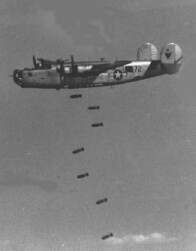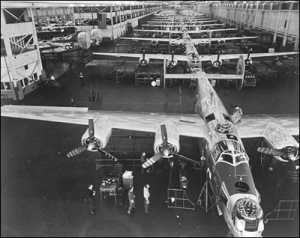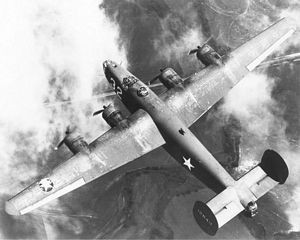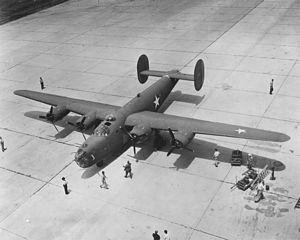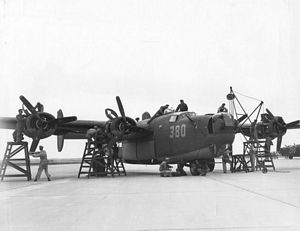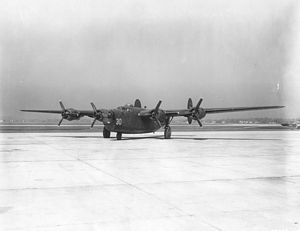Consolidated B-24 Liberator
18,188 planes produced, entered service 1940
B-24D specs: top speed 303 MPH, 11 machine guns, max. bomb load 8,000 lbs.
By Stephen Sherman, Aug. 2002. Updated January 21, 2012.
August 1, 1943 - Over Ploesti, Romania, German-occupied Europe:
The Vagabond King, B-24 Liberator #42-40787, shook from the flak concussions, from bullets smashing its windows, and from the roaring rumbling of its four Pratt & Whitney R-1830 fourteen-cylinder radial engines. 1st Lt. John McCormick cursed as the gunner in the top turret opened up with his twin fifties. He was ruining the bomb run! And McCormick wanted to hit this target, the Steaua Romana oil refinery outside Ploesti. General Brereton had told them this raid could shorten the war by six months.
McCormick barked out orders to his crew, just as he had done so often in the past two weeks, when the 389th Bomb Group practiced for Operation "Tidal Wave" over the godforsaken Libyan desert outside Benghazi.
"Mosco, bomb bay doors open," to the bombardier, 1st Lt. Marvin Mosco.
"Start the camera, Van," to the radioman, enlisted man Martin Van Buren.
He steadied the stick as the big Liberator sped along the deck at 225 mile per hour, staying close to Hitler's Hearse, Captain R.C. Mooney's plane immediately ahead, so that Mooney's bombs, with 45 second delay fuses, didn't blow up in Vagabond King's nose. Down at chimney height, as black smoke from the bombs and sooty burning hydrocarbons boiled up all around them, suddenly "Bombs away!" and Vagabond jumped up, 4,000 pounds lighter. At that instant, the Hearse, grimly lived up to its name, as it took several direct hits, killing the Capt. Mooney. As more bullets tore into his own bomber, McCormick hoped those workers at Consolidated's San Diego plant had been paying attention when they built his plane. The Vagabond had taken a lot of punishment; one anti-aircraft shell had hit Van and he was a bloody mess.
Paul Miller, the gunner in the A-6 power tail turret, reported that their particular target, the boiler house, had been flattened and was burning fiercely. McCormick hugged the deck as he made his getaway, figuring that the German fighters couldn't dive on them down that low.
The Vagabond King headed south, desperate to get medical attention for the badly wounded Van. They flew over Turkey and touched down at Nicosia airfield, Cyprus as it was getting dark, fourteen hours after they had taken off. They were one of the lucky ones; of 178 B-24's that took off that morning, 54 didn't come back.
More pictures of B-24s and other bombers at Photo Gallery 2.More B-24's were built than any other American airplane. It edged out the B-17 on most performance criteria (speed, range, bombload). It's crewmen claimed 2,600 enemy aircraft shot down. With it's great range, it performed anti-sub work in the Atlantic and heavy bomber support in the Pacific.
Design and Development - Early B-24's
The B-24 originated in a 1938 request by the Air Corps for Consolidated Aircraft to produce B-17's. But Consolidated's engineer, David Davis, had designed a wing suited for long-range bombers, a wing that offered 15 percent less drag than ordinary wings. Consolidated's engineers sketched out a rough version of a bomber using Davis' wing in late 1938. It would be a four-engine, high-wing, tricycle landing gear, dual bomb bay aircraft.
USAAC General Hap Arnold approved the plans and in March, 1939 Consolidated was granted a contract for its Model 32 or XB-24. Consolidated's prototype, delivered in December, was stumpy and not-very-attractive. Personally, the look of the two large oval tail fins seems inelegant. The bomb bay was unique. The four bomb doors operated much like suburban garage doors and rolled up along the outside the fuselage. In between, along the bottom of the fuselage ran a narrow catwalk. Interestingly, the crew normally went in and out of the Liberator through the bomb bay doors. Powered by four 1,100 hp Pratt & Whitney R-1830-33 Twin Wasp engines, the prototype could make 273 MPH - before turbo-superchargers were added.
Even before the prototype's first flight, the Air Corps contracted for seven YB-24's and the French ordered 175 (most of these eventually wound up in the RAF). One of the was customized as Winston Churchill's personal transport aircraft.
The Army ordered 120 examples of the B-24A in mid-1939. Twenty of these ended up in British service, known as Liberator I. The RAF used them for anti-submarine work, adding radar antennnae all over and four 20 mm cannon in the nose. With the Liberator's 2400-mile range, they were able to patrol for out into the Atlantic. Nine of the original B-24A order served with the USAAF as transports, including the September 1941 Harriman mission to Moscow and a top-secret spy flight over Japanese Pacific bases. The remaining 91 airframes were finished as "C"s or "D"s.
Dissatisfied with the 273 MPH of the first B-24, the Army specified a turbo-supercharged engine in the experimental XB-24B. Powered by 1200 hp Pratt & Whitney R-1830-43 engines, this plane met the Army's requirements, with a top speed of 310 MPH. It also featured self-sealing fuel tanks, as did all subsequent B-24s. (There was a definite trend to the modifications in WW2 bombers - more guns, better engines, more armor, self-sealing fuel tanks, bigger bomb loads. They all seem to follow that general pattern.)
The B-24C represented the next step in the evolution of the B-24, incorporating advances from the XB-24B and from the British combat experience with the Liberator. The "C" model included eight .50 caliber machine guns: one in the nose, one in the belly, two in a tail turret, two in a dorsal turret (just aft of the cockpit), and two in the waist. Its nose was three feet longer than earlier versions. Only nine B-24C models were ordered, all restricted from combat use.
Production Pool
To meet the foreseen large demand for the B-24, the government set up a consortium of aircraft manufacturers and plants to build the plane:
- CO - Consolidated/San Diego plant
- CF - Consolidated/Fort Worth plant
- DT - Douglas/Tulsa plant
- FO - Ford/Willow Run plant
- NT - North American/Dallas plant
The story of Ford's Willow Run plant could fill a book in itself. They broke ground in April, 1941; by September, it was complete - an 80 acre factory. Dormitories were built on the site and a commuter rail line was extended to it. Designed by Ford executives like Charles Sorenson, Willow Run got off to a slow start, as its automobile, assembly-line style of manufacturing had to be adapted to aircraft production. By mid-1943, with 42,000 employees, it began to turn out B-24s - 230 per month. By the end of 1944, 650 per month. When production ended in April, 1945, Willow Run had turned out over 8,600 Liberators.
The Liberator Production Pool did not operate completely trouble-free. Parts made by different factories were not always interchangeable, and implementing the countless required changes consistently was a headache. Eventually, separate "modification centers" were set up to upgrade planes that had just left the factory, but were already obsolescent.
Consolidated B-24 Liberator (Production Line to Frontline #4) by Michael O'Leary, tells more of the B-24 production story.
B-24D
The "D" was the first B-24 to be qualified for combat. Under the original Production Pool plan, Consolidated/San Diego was the prime manufacturer, supplying components to Fort Worth and Douglas/Tulsa for assembly. In May, 1942 the first of 2738 B-24D's rolled off the assembly lines.
Due to rapidly changing needs, especially for defensive machine guns, there were many variations within the B-24D model, these differences identified by "production blocks" (e.g B-24D-70-CO). Various ventral gun systems were tired, including a totally unworkable, Bendix turret theoretically aimed with a periscope. Another, familiar problem was inadequate firepower in the nose. In the "D" two cheek guns were added, but didn't work out so well.
Specs for late model B-24D:
- Four Pratt & Whitney R-1830-43 fourteen-cylinder radial engines, rated at 1200 hp.
- Performance: Maximum speed 303 mph at 25,000 feet.
- Service ceiling: 32,000 feet.
- Range: 2300 miles with 5000 pounds of bombs. Maximum range 3500 miles.
- Fuel capacity: 3614 US gallons.
- Dimensions: Wingspan 110 feet 0 inches, length 66 feet 4 inches, height 17 feet 11 inches, wing area 1048 square feet.
- Weights: 32,605 pounds empty, 55,000 pounds gross, Maximum takeoff weight 64,000 pounds.
- Armament: Bomb bay could accommodate up to eight 1600-pound bombs.
- The late model "D"s included eleven .50 caliber machine guns: three in the nose, two in the belly turret, two in a tail turret, two in a dorsal turret (just aft of the cockpit), and two in the waist
A few non-numerous production variants included: the B-24E - produced at Willow Run, similar to the "D" model; C-109 - a tanker conversion of the B-24E, capable of carrying 2,900 gallons of fuel, used over "the Hump;" and the B-24G - North American's model, all equipped with the nose turret.
B-24H
Trying to increase forward firepower, some 90th Bomb Group field engineers got the bright idea to install a cannibalized B-24 tail turret in the nose. It worked pretty well, and an Emerson A-15 twin-gun nose turret was standardized on B-24H's. The top and tail turrets were improved, and the camouflage paint was omitted late in the "D" series. 3,100 were produced, over half at Willow Run.
B-24J
Essentially the same as the B-24H; but early "J"s were equipped with the Convair (merged Consolidated/Vultee) A-6A nose turret, instead of the Emerson A-15 turret, due to a limited supply of the Emerson turrets. By early 1944, enough Emersons were available for all five factories. The B-24J was also equipped with an improved C-1 automatic pilot, a new M-series bomb sight, an electronic control system for the turbosuperchargers, and a better fuel transfer system.
At first, only the two Convair plants manufactured the B-24J, with Ford/Willow Run and Douglas/Tulsa continuing to produce the B-24H and North American/Dallas continuing to build the B-24G. However, in early 1944, the Army directed that the C-1 automatic pilot and the M-series bombsight be installed on all production Liberators under the designation B-24J. For the first time, all five members of the Liberator Production Pool would be building aircraft under the same designation. Ford/Willow Run produced its first B-24J in April of 1944, with Douglas/Tulsa and North American/Dallas following in May. (This paragraph quoted directly from Joe Baugher's B-24 page.)
Excessive weight was a real drawback of the B-24J; numerous additions totaling 8,000 pounds had been made since the B-24D, but the same engine. Performance, fuel efficiency, and flight stability fell off because of this excess weight. (Sounds like what my wife and my doctor tell me.)
6678 B-24J's were produced. By late 1944, the Army foresaw a lessened demand for Liberators, and ordered that three of the plants be freed up for other purposes. Only Ford-Willow Run and Convair-San Diego continued turning out B-24's in 1945. Late in the B-24 program, attempts were made to trim its weight (in the Pacifc, field engineers had been removing the belly turrets to save weight). The result was the B-24L, some 1,000 pounds lighter than the "J," of which 1667 were built, mostly at Willow Run.
Specs of B-24J (key differences from B-24D in boldface)
- Four Pratt & Whitney R-1830-65 fourteen-cylinder radial engines, rated at 1200 hp, with GE turbosuperchargers
- Performance: Maximum sustained speed 278 mph at 25,000 feet.
- Service ceiling: 28,000 feet.
- Range: 1700 miles at all-up weight of 61,500 pounds.
- Fuel capacity: 3614 US gallons.
- Dimensions: Wingspan 110 feet 0 inches, length 64 feet 2 inches, height 18 feet 0 inches, wing area 1048 square feet.
- Weights: 38,000 pounds empty, 55,000 pounds gross, Maximum takeoff weight 71,000 pounds.
- Armament: Bomb bay could accommodate up to eight 1600-pound bombs.
- The late model "D"s included eleven .50 caliber machine guns: three in the nose, two in the belly turret, two in a tail turret, two in a dorsal turret (just aft of the cockpit), and two in the waist
About 1600 late model B-24's (H, G, and L) were delivered under Lend-Lease to Britain. The RAF used them for anti-submarine work, day bombing, and as transports.
PB4Y-1 - The Navy's Liberator
Interservice rivalry did not disappear during World War Two. While the Navy wanted a heavy, land-based bomber for patrol, anti-sub, and reconnaissance, the Army resisted such intrusion on its turf. But the Army needed the production capacity at factory in Renton that was committed to Navy projects. The two services made a deal; for its part, the Navy got "navalized" B-24's and other bombers, as well as agreement for it to carry out its own maritime patrol, photographic, and transport work.
The Navy (including the Coast Guard and Marine Corps) acquired 977 PB4Y-1's and equipped 24 VPB (Patrol Bombing) squadrons with them. Operating in both the Atlantic and Pacific, the PB4Y-1's destroyed 13 Axis submarines.
Over Europe - 8th Air Force
Twenty-one Bombardment Groups (BG) of the Eighth Air Force would fly the B-24. While five transitioned to the B-17, sixteen were still equipped with Liberators when the Eighth was re-organized in four Air Divisions in mid-1944.
The first being the 93rd BG which joined the 8AF in April, 1942. Another 1942 arrival was the 44th BG, the "Flying Eightballs."
Other groups included the 25th BG, 34th BG, 44th BG, 93rd BG, 389th
BG, 445th BG, 446th BG (in Dec. 1943), 448th BG, 453rd BG (Jimmy
Stewart's group), 458th BG, 466th BG, 467th BG (arriving in March,
1944), 482nd BG, 486th BG, 487th BG, 489th BG, 490th BG, 491st BG,
492nd BG, and 493rd BG.  B-24
Liberator Units of the Eighth Air Force (Osprey Combat Aircraft 15)
by Robert F. Dorr, tells their stories.
B-24
Liberator Units of the Eighth Air Force (Osprey Combat Aircraft 15)
by Robert F. Dorr, tells their stories.
Perhaps representative of the Eighth's Liberator Groups, the Wendling-based 392nd BG flew 285 combat missions. Starting in September, 1943, with a mission to Abbeville, through April 25, 1945 when the 392nd flew the last bombing mission of the Eighth Air Force, hitting rail yards near Hallein, Austria.
On a typical mission, July 7, 1944, the Group launched forty-two Liberators toward Bernberg, and lost six, with five crews MIA. With the staggering losses of the Eighth Air Force (80,000 casualties), it's often difficult to put a face on them. Perhaps the details of one B-24, #42-95229 "RAP ‘EM PAPPY" will help:
MISSION LOSS CIRCUMSTANCES: Returning aircrew eye-witness reports (Lt. Neiderriter, crew Pilot, 579th, and Lt. Fleck, crew Bombardier of Lt. Leser’s crew, 579th) stated that this aircraft was attacked by enemy aircraft after bombs away; dropped the nose gear; then most of the landing gear came down with plane leaving formation under control with #3 engine windmilling; #4 engine out, and some flames coming from the ship. ...
German Report #KU2429 ... reported this ship crashed at 0920 hours near Rhoden, (7) kilometers northeast of Osterwielk on 7 July. Crew members Ruvolis, Mayer, Young, and Beltz were captured between 1030-1050 hours in the same general vicinity of Osterwielk, same day. Sheridan, as the 5th member captured, was taken prisoner in the same general location at 1115 hours Three (3) crew men were found dead near the crash location some with remains badly charred: Wunderlin, Schenkenberger and Garvey - later in the day. The Engineer, Sgt. Cowley, was found badly injured and was taken to a General Hospital at Wernigerode where he died two days thereafter. Another member, Sgt. Beltz, and one of the prisoners was found wounded and was later taken to the POW Hospital at Magdeburg on 9 July. Local burials were given to all deceased men. ...
A bizarre situation unfolded in later statements of at least two survivors on the fate of the Co-Pilot, Lt. Wunderlin, who was found dead near the crash site. It was reported in one statement, admitted as supposition to some degree, that there was "a possibility that his (Lt. Wunderlin’s) chute fouled (did not deploy), but that is unlikely (because) Ed Young, the Bombardier, overheard German conversation in which the Germans claimed that he was Jewish....they had in some way found his bail out pictures". Lt. Ruvolis, the Pilot, had stated that the Co-Pilot had definitely bailed out of the nose well hatch safely along with the others who exited there.
Another surviving member on Lt. Wunderlin’s fate noted in his Casualty Questionnaire:
"At the time I was questioned by the Gestapo and police, they showed me Lt. Wunderlin’s escape picture and asked me if I knew where he was. I denied knowledge of German (language). They then showed me the parachute packing slip from Lt. Ruvolis’ (the Pilot) chute, and I presumed that the Co-Pilot had been wearing Lt. Ruvolis’ chute; that he had come down safely and doffed his coveralls, inadvertently leaving his escape pictures in the pocket; and was roaming around somewhere. One of the Gestapo then started to ask me if Lt. Wunderline was Jewish. I again denied knowledge of German (none of my interrogators spoke English). They then started insisting he was Jewish, and when I later heard he (Lt. Wunderlin) was still MIA and tied it into the attitude of these men, I came to the conclusion they had themselves shot him on the presumption that he was Jewish."From 392nd BG website, a storehouse of information, including comparable details on every lost plane.
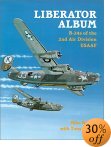 Liberator
Album: B-24 Liberators of the 2nd Air Division, USAAF by Mike
Bailey
Liberator
Album: B-24 Liberators of the 2nd Air Division, USAAF by Mike
Bailey
The Mediterranean - 15th Air Force
Ploesti
No history of the B-24 would be complete without the story of Ploesti, "Black Sunday," August 1, 1943. As part of the Army Air Force's chosen role as a "strategic" force, not merely "flying artillery," the USAAF planners quickly focused on the Reich's dependence on oil, largely produced and refined in the Balkans. Ploesti, in Romania, was a large center of the oil industry, accounting for one-third of German oil and aviation fuel. Accordingly, the U.S. military planners identified it as a high priority target. It even suffered an early air raid from the pioneering Halvorsen Group in mid 1942.
But in 1943, Generals Brereton planned a much larger mission, dubbed Operation "Tidal Wave." Liberator Bomb Groups from the Eighth Air Force were loaned to the Mediterranean Theater Air Forces for the assignment. Eventually, five Bomb Groups (the 44th, 93rd, and 389th (of the Eighth Air Force) and the 98th and 376th of the Ninth Air Force), 178 Liberators, and over 1,700 aircrew would participate. Starting in mid-July, the bomber crews based at Benghazi, Libya, practiced for the mission, flying over a huge mock-up of the Ploesti target. Bomb Groups, Squadrons, and even individual airplanes had their particular targets. They hoped to achieve surprise; the long range mission would have no fighter cover. To ensure maximum destruction, the Liberators would drop their bombs from treetop level. While the planners hoped for surprise, they anticipated huge casualties, perhaps half of the attacking force.
According to the plan, Brig. Gen. Uzal Ent, flying in Teggie Ann with Col. Keith Compton's 376th BG, would lead the five groups over oil refineries in Ploesti and nearby Campina and Brazi. Taking off from Benghazi, Libya between 0400 and 0500,the bombers would fly over the west coast of Greece, across southern Albania & Yugoslavia, and then descend onto the Romanian industrial plain along the Danube River. The Bomb Groups planned to diverge at Pitesti, to hit all targets in all three cities simultaneously.
En route, the bomb groups became separated, and a route navigator aircraft crashed. After climbing over the mountains, and then descending, the two lead groups (the 376th and 93rd) were half an hour ahead of the other three. The element of surprise, if it ever existed, was lost. Even worse the 93rd and 376th BG's took a wrong turn at Targoviste. For these groups, the carefully planned target assignments were gone. General Ent broke radio silence, and ordered the bombers to turn north and hit targets of opportunity.
Leading the 93rd in Hell's Wench, its CO Col. Addison Baker and the pilot, Major John Jerstad, headed for the refinery at Columbia Aquila. Flying through tremendous flak, their plane was hit and caught fire. Rather than bail out or belly in, these two officers led their group straight onto the target, sacrificing themselves to salvage what they could of the critical mission. They both were awarded the Medal of Honor.
Col. John R. "Killer" Kane, CO of the 98th, and Col. Leon W. Johnson, CO of the 44th, led their groups right over Ploesti, as planned, except that German defenses had been fully alerted and there were half as many bombers to "saturate" them. 18 of Kane's 41 bombers were shot down. His own plane crash-landed at Nicosia, Cyprus, along with the Vagabond King, described above. The 44th got split up; only 16 Liberators followed Johnson and Kane; 7 of those were destroyed. (Cols. Kane and Johnson also earned the MOH.)
Other units hit outlying refineries at Brazi and Campina, and did not suffer as terribly. Lt. Col. James Posey led twenty-one of the 44th BG's bombers over Brazi, and the 389th under Col. Jack Wood bombed Campina.
The best book I've seen on Operation Tidal Wave is  Ploesti: The Great
Ground-Air Battle of 1 August 1943, by James Dugan &
Carroll Stewart. It includes over 80 contemporary photographs and
several maps and diagrams, ilustrating hgow the bombers flew in
formation, missed their turns, etc. The books is very detailed,
practically a plane-by-plane history of the mission. Nor does it
neglect the lead-up and planning, the German side, or the many prisoner
of war stories.
Ploesti: The Great
Ground-Air Battle of 1 August 1943, by James Dugan &
Carroll Stewart. It includes over 80 contemporary photographs and
several maps and diagrams, ilustrating hgow the bombers flew in
formation, missed their turns, etc. The books is very detailed,
practically a plane-by-plane history of the mission. Nor does it
neglect the lead-up and planning, the German side, or the many prisoner
of war stories.
Ploesti Mission Results: Of seven target refineries, one was permanently destroyed; two were untouched; two were shut down completely for several months; and two had production greatly reduced for some time.
Mission Losses: 178 bombers took off from Benghazi. 16 aborted or crashed. 162 reached targets around Ploesti. 51 were shot down or interned in Turkey. 22 landed at various Allied bases in the Mediterranean. Of the 89 that returned to Benghazi that day, 58 were damaged beyond repair.
The Wild Blue
This 2001 book offers another chapter in the apparently unending story of the B-24 Liberator. Like all of Stephen Ambrose' s books, it is detailed and readable, but this one is controversial (or least surprising) for two reasons. First, the book is almost entirely devoted to George McGovern and his crew. McGovern went on to become U.S Senator from South Dakota, and in 1972, a peace candidate for President. As such, he ws unpopular with traditionally hawkish veterans groups. It's a fair measure of McGovern's character that he never boasted of his real, heroic combat career, which earned a Distinguished Flying Cross, in contrast to Nixon's desk-bound service. Thus the book is not really about "the men who flew the B-24s," as much as it is about setting the record straight about one man who flew B-24's.
Ambrose tells a good story, a readable narrative. He weaves in biographical backgrounds of the crew (like C.W. Cooper from a devout Baptist family in McCaulley, Texas), descriptions of the Liberator (stressing how physically challenging it was to fly), an overview of the air war in Europe, McGovern's training on the twin engine AT-9. He details the origins of the Fifteenth Air Force, including the famous Ploesti mission, thus providing a rich context for McGovern's missions in late 1944. Personal touches abound, like the first CO of the 455th Bomb Group, the aptly named Col. Kenneth A. Cool, who, when surprised, would puff on his pipe and say, "Well, I'll be dipped in gravy."
 The
Wild Blue: The Men and Boys Who Flew the B-24s over Germany 1944-45
by Stephen E. Ambrose
The
Wild Blue: The Men and Boys Who Flew the B-24s over Germany 1944-45
by Stephen E. Ambrose
While the narrow focus of the subject may have been a little surprising, the author's plagiarism was highly controversial. The Wild Blue is well-written, or perhaps "well-assembled," but numerous passages were lifted from other, uncredited, sources. The prolific Ambrose (two books a year) admitted his "mistake," and promised to be more careful in the future.
The Pacific
B-24 Liberator Units of the Pacific War (Osprey Combat Aircraft 11) by Robert F. Dorr.
The B-24 flew with 5th and 13th Air Forces, supporting the U.S. advance up the Solomons, through New Guinea, and into the Philippines. The B-24 also flew with the 7th Air Force in the Central Pacific, island hopping from the Carolines, Marshalls, Marianas and Palaus to Okinawa. On the way, the 7th bombed such places as Truk, Kwajalein, Guam, Saipan, Iwo Jima, Peleliu, Anguar, China and Japan and the Philippines.
Sources:
Joe Baugher's B-24 web article
WW2 Aircraft Nose Art - featuring 22nd Bomb Group B-24s based at Okinawa
B-24 Liberator Units of the Eighth Air Force (Osprey Combat Aircraft 15) by Robert F. Dorr
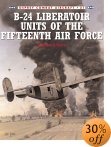 B-24
Liberator Units of the Fifteenth Air Force (Osprey Combat Aircraft 21)
by Robert F. Dorr, includes an excellent illustrated writeup of the
Ploesti mission, even though it was carried out by the Ninth Air Force
(the Fifteenth AF did not come into existence until November, 1943.)
B-24
Liberator Units of the Fifteenth Air Force (Osprey Combat Aircraft 21)
by Robert F. Dorr, includes an excellent illustrated writeup of the
Ploesti mission, even though it was carried out by the Ninth Air Force
(the Fifteenth AF did not come into existence until November, 1943.)
Consolidated B-24 Liberator by Martin A. Bowman
Ploesti: The Great Ground-Air Battle of 1 August 1943
Into the
Mouth of Hell, by John A. Frisbee, in Valor, the AFA magazine,
September 1988, Vol. 71, No. 9

